Making PPP legal frameworks fit for post-COVID-19

Photo Credit: Image by Queven from Pixabay
Authored by: Christina Paul
This article has also been cross-published on the World Bank PPP Blog. Click here to view.
The current COVID-19 crisis has strained infrastructure projects globally, and in particular public-private partnerships (PPPs), at all stages and in all sectors—with implications for governments, providers of infrastructure assets and services, their financiers, and end-users. An opportunity to build better for the future The Practice Note on PPP Legal Frameworks Post-COVID-19 recently released by the World Bank’s Infrastructure Finance, PPPs & Guarantees group (IPG) aims at exploring these issues and more that merit consideration when assessing PPP enabling frameworks for their fitness in a post-COVID-19 era. We held a webinar to discuss the note that was well attended and brought robust discussion; watch it here if you missed it.
While all players share a common goal: to prevent the failure of PPP programs and projects, actions taken so far have often been ad hoc and focused on remedying the pandemic’s effects in the short term. In many cases these included, for example, making use of customary relief mechanisms under PPP contracts as well as arrangements between governments, sponsors, and lenders to come to practicable temporary solutions and avoid disputes.
But, six months into the pandemic it’s clear we’re in this for the long haul. There’s now a need to move beyond short-termism and address holistic implications for the PPP model itself and infrastructure development more generally. It’s time to start contemplating and actively designing measures that account for the long-term implications of COVID-19 on PPP programs.
For governments this necessarily includes taking a closer look at their current project pipelines and enabling policy, legal, and institutional environments. Are they fit for better mitigating future similar crises given the likelihood of PPPs being particularly affected due to their long-term nature? Do PPP legal frameworks in particular merit adaptation to enable greater resilience of PPP structures to external shocks? The way in which both portfolios and PPP frameworks are revisited will have an important signaling effect to the private sector and ultimately determine investors’ and financiers’ interest in re-entering markets in a post-COVID-19 world.
When beginning to think about corrective strategies for the long term, the pandemic—though grave in its impacts—holds a major opportunity to advance better PPP enabling frameworks going forward. We will undoubtedly learn important lessons during mitigation and recovery phases that can improve PPP programs. For instance, we already know that short-term actions taken by governments so far appear to have been particularly successful when they consulted with all relevant stakeholders prior to their issuance. They did well to mobilize the relevant ecosystems and ensure sufficient clarity and flexibility in applying these measures.
Importantly, the impacts of the COVID-19 crisis have highlighted certain critical aspects under PPP policy and legal frameworks that underpin the preparation and implementation of good-quality and sustainable PPP projects. These include:
To further advance global discussions in this context and assist governments in revisiting PPP frameworks, we’ll also develop a practitioner’s tool that identifies key provisions of PPP legislation and highlights those elements critical for building resilience in PPP structures.
To contribute to making PPP legal frameworks fit for a post-COVID-19 world, we therefore hope for broad participation from both public and private sectors, civil society, and the international development community in the consultations on the envisaged guide once an advanced draft will be available during the first quarter of 2021.
Updated: June 2, 2024
Related Content
Covid-19 and PPPs
Page Specific DisclaimerThis is a new section of the PPPLRC website and is currently in draft form. Your feedback is welcome: If you would like to comment on the content of this section of the website or if you have suggestions for links or materials that could be included please contact us at ppp@worldbank.org.
KeywordsCovid-19 and PPP Resources
Page Specific DisclaimerThis is a new section of the PPPLRC website and is currently in draft form. Your feedback is welcome: If you would like to comment on the content of this section of the website or if you have suggestions for links or materials that could be included please contact us at ppp@worldbank.org.
KeywordsCovid-19 and PPP Contracts
Type of ResourceCovid-19 and PPP Blogs
Page Specific DisclaimerThis is a new section of the PPPLRC website and is currently in draft form. Your feedback is welcome: If you would like to comment on the content of this section of the website or if you have suggestions for links or materials that could be included please contact us at ppp@worldbank.org.
Keywords